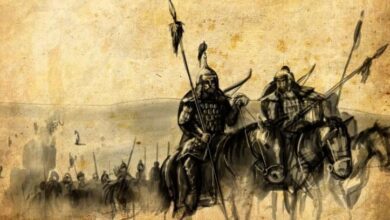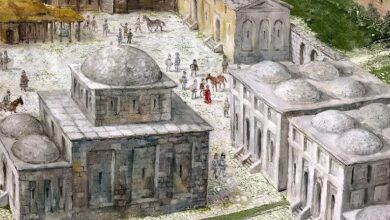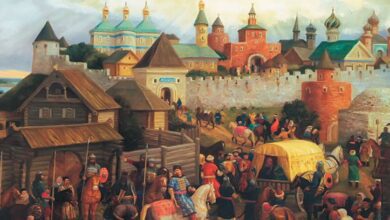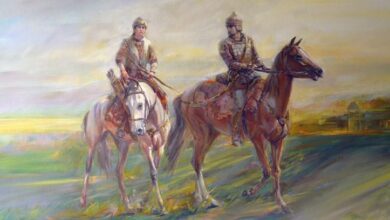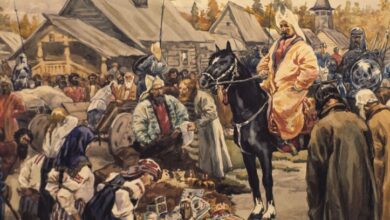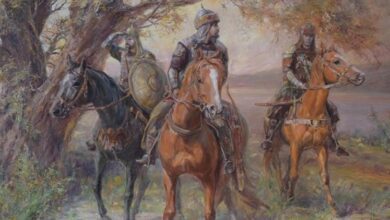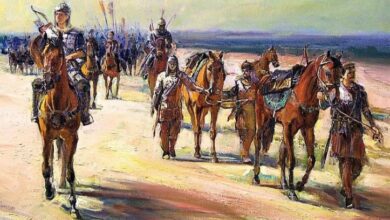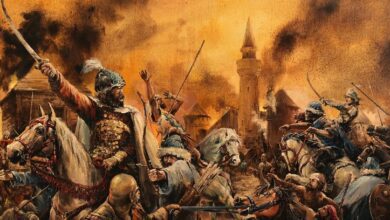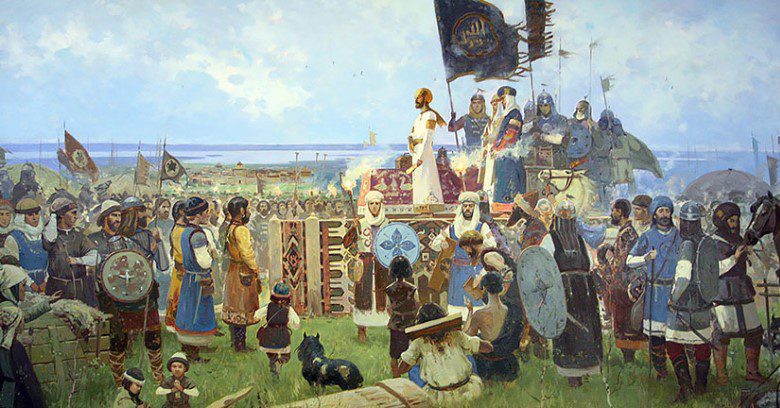
Volga Bulgars. Introduction
EIf history is presented as some systematized description of events that have taken place in the life of a people, country and state, then it remains possible to come to any conclusions, because there are no theoretical and methodological frameworks arising from historical patterns that allow directing the researcher's thinking to the truth. It is this circumstance that often turns historical science into a servant of ideology and politics. But there are no researchers who would deny the existence of historical patterns. Nevertheless, quite a few historians vehemently resist the penetration into the description of historical events of methodological requirements formulated on the basis of theories explaining the historical process. One of the reasons for this circumstance, apparently, is that in this case history becomes a science and it can no longer be arbitrarily used to justify certain ideological attitudes.
Until now, most historians have answered only the question “How does this happen?”, Leaving in the shade another equally important question for understanding historical processes, “Why does this happen?”. In our time, the most acceptable answer to the last question was given by LN Gumilyov (1912-1992). For the first time in science, he managed to solve the problem of ethnogenesis - the origin and development of peoples - at the level of scientific achievements. XX in. Based on his theoretical research, he gave vivid examples of the presentation of the ethnic history of the Slavic-Russian and Turkic-Tatars. Let us briefly consider what is the essence of the theoretical studies of L.N.
LN Gumilyov comprehensively investigated the causes and conditions for the emergence of ethnic groups. According to him, at least two reasons cause the emergence of a new ethnic group: firstly, the presence on the same territory of representatives of two or more ethnic groups that have disintegrated from old age (or for other reasons), which he called ethnic substrates and, secondly, the impact on an ethnic system of cosmic radiation arising from ethnic substrates, which charges it with energy sufficient for an ethnos to go through its life cycle with a natural duration of 1500 years. Thus, a passionary push occurs, i.e. the birth of an ethnic group. Ethnicity, points out LN Gumilyov, is a natural phenomenon and serves as the basis on which its social system with all its spheres of life arises. The life cycle of an ethnic group consists of a number of phases. Each phase corresponds to a certain passionarity, i.e. greater or lesser vital energy, which depends on the number of active and passionate people in the ethnic system, thirsting for activity in the name of the well-being of their people (passionaries). The author of this work built his work on the basis of the teachings of LN Gumilyov about the phases of ethnogenesis. It was, as it were, a canvas in the description of the ethnic history of the Volga Bulgars.
LN Gumilyov deeply and comprehensively developed the entire process of ethnogenesis, from its beginning to end, described the phases of ethnogenesis, brought them into a coherent system. A passionary push leads to the emergence of a new ethnic group from several ethnic substrates (usually 2-3). The emerging ethnos in its development goes through the following phases: 1) the rise phase, which has incubation and explicit periods; 2) akmatic phase; 3) the breaking phase; 4) phase of inertia; 5) obscuration phase; 6) the phase of homeostasis. If an ethnic group successfully overcomes all these phases, it turns into a relic and can exist indefinitely until its neighbors violate its state by committing aggression against it. The regeneration of an ethnos is also possible, which leads to the revival of its vitality to perform worthy deeds from the point of view of world history.
Ethnic groups have different ages depending on what phase of their ethnogenesis they are in. The behavior of an ethnic group and its constituent people change depending on the age of the ethnic group. The imperatives of behavior, as L.N. Gumilyov defines them, consist in the following principles: in the lifting phase - “Be who you should be” (here duty is above all), in the akmatic phase - “I want to be myself!” (I fulfill my duty, but I also have my own affairs), in the breakdown phase - “Be yourself” (duty begins to burden people, “the right of strength takes the place of the strength of duty”), in the phase of inertia - “We are tired of the great! ” (the philistine, passive for society, but hardworking for himself, comes to the fore), in the phase of obscuration - "Be like us!" (“Aspire not to anything that cannot be eaten or drunk”). In the phase of homeostasis, as it were, there is a return to the inertial phase. A person in this phase has a harmonious mentality. He knows how to appreciate the exploits and heroic deeds of his ancestors, but he himself is not capable of them; he recalls with sincere admiration the “traditions of antiquity,” which is why this phase can also be called “memorial”.
As a result of the passionary impetus in the ethnic group, the number of passionaries sharply increases, breaking the established relationships between people. From the point of view of their fellow tribesmen, they act non-standard, defiantly, violating the ethnic, legal and traditional norms in force in society. But during the incubation period of the rise phase, which lasts about 150 years, events worthy of a chronicler or historian do not occur (only minor skirmishes within the ethnic group, fermentation of minds, unrest, fratricide, etc.).
The end of the incubation period of the rise phase marks the emergence of an ethno-social system—various forms of national statehood. For the ethnos, a clear period of a phase of ascent begins, the events of which are noted by chroniclers, both their own and those of others. The explicit period of the rise phase lasts approximately 100-150 years. “The phase of the rise of ethnogenesis is always associated with expansion, just as heated gas expands,” notes LN Gumilyov[i]. It is in this phase that the masses of the conquered ethnic groups merge into a single system with the passionate ethnic group that conquered them, most often forming a superethnos.
With the transition of an ethnos from the ascent phase to the akmatic phase, the desire to expand the range intensifies. In practice, an ethnos that is in the first phases of ethnogenesis cannot be conquered, because for this the aggressor ethnos must expend such an amount of energy that it cannot be recouped by any success. However, transitions from one phase to another carry dangers for the ethnos - it is precisely at these moments that it is especially vulnerable. In the akmatic phase, the merging of two or three colliding ethnic groups usually ends.
The Akmatic phase, which lasts approximately 300 years, is characterized by the highest level of passionary tension for this ethnic system. Passionaries of the sacrificial type dominate in this phase, superethnoi are formed, consisting of subethnoi (subsystems). Passionaries seek to establish themselves as individuals, they see the victories of their ethnic group through the prism of their personal victories. However, an excess of passionarity in the akmatic phase often leads the ethnos to a state that L.N. Gumilyov calls “passionary overheating”.
Passionary overheating, which arose as a result of an excess of passionarity in an ethnic group, leads to an intra-ethnic struggle, which reduces the resistance (resistance) of the ethnic system. “Overheating is possible,” writes L.N. During the period of passionary overheating, passionate ethnic groups turn out to be not champions of their former positive ideals, but opponents of their neighbors. At the same time, technical superiority plays a paramount role here.
After the akmatic phase, the ethnos enters the breaking phase. “... A break is a serious age-related disease and not every ethnic group is destined to survive it,” notes LN Gumilyov[iii]. A sharp decrease in passionary tension is accompanied by a split in the ethnic field, which leads to sharp conflicts within the ethnic system. In this phase, there is a great danger of the collapse and death of the ethnic system as a result of displacement, that is, negative ethnic contact and the emergence and action of anti-systems, because its resistance is low. Passionaries perish in wars for the expansion of the range of their ethnic group and in intra-ethnic struggle, subpassionaries come to the fore, i.e. people are inactive, passive. The remaining passionaries are forced out to the outskirts of the area occupied by the ethnic group.
LN Gumilyov called the inertial phase of ethnogenesis “the golden autumn of civilization”. In this phase, there is a further decline in the level of passionary tension. It lasts approximately 300 years. The scientist describes its content as follows: “In this autumn, they gather fruits, accumulate wealth, enjoy peace disturbed only by external wars, expand the territories of their states and tolerate, albeit reluctantly, great thinkers, artists, writers, and sometimes even do not let them die with hunger”[iv].
In the inertial phase, fatigue from the experienced shocks prevails and the townsfolk try to get rid of the passionaries, who, as always, “like to muddy the waters”, they are pushed out, they either die or go to the outskirts, and sometimes to other countries. These skirmishes with passionaries are the last battle of the townsfolk in their quest for peace. It is easy for intelligent leaders in the phase of inertia to manage the people who live off the traditions and wealth accumulated by past generations.
The concept of “civilization” fits into the framework of this phase, when technology is improved, production develops, life is streamlined, ethnographic features are erased, the population is urbanized, and science and culture flourish in cities. The townsfolk accumulate wealth, and passionaries go into the sphere of science and art. “Immorality and lawlessness in cities,” writes L.N. With the previous increase in passionarity, a characteristic feature was severity both towards oneself and towards one's neighbors. With a decrease, “philanthropy”, forgiveness of weaknesses, then neglect of duty, then crime is characteristic .... The level of morality of an ethnos is the same phenomenon of the natural process of ethnogenesis as the predatory extermination of living nature”[v].
Finally, the “twilight” of the ethnos sets in, its old age is the phase of obscuration, which occupies a period of 200 (sometimes more) years in ethnogenesis. Passionary voltage decreases to a level below zero. The ethnos exists at the expense of material and cultural values accumulated in the inertial phase. Subpassionaries, who invariably outnumber passionaries, block any creative activity of the latter, demanding satisfaction of their ever-increasing needs. Here is how L.N. Gumilyov describes the phase of obscuration: “Any growth becomes an odious phenomenon, diligence is ridiculed, intellectual joys cause rage. In art there is a decline in style, in science original works are supplanted by compilations, in public life corruption is legalized, in the army soldiers keep officers and generals in submission, threatening them with rebellions. Everything is corruptible, no one can be trusted, no one can be relied upon, and in order to rule, the ruler must use the tactics of a robber chieftain: suspect, hunt down and kill his comrades-in-arms”[vi].
By the end of the obscuration phase, the population of the ethnic group is reduced, representatives of the outskirts rush to the center, the influx of individuals of foreign ethnic groups is increasing, some are indifferent, others are trying to appropriate everything that is badly lying - be it material values or power. The ethnic system is losing resistance, which can be used by passionate neighbors. “Reducing the passionarity of the tension of the ethnic system, of course, is not good,” writes L.N. However, it must be borne in mind that the phase of obscuration ends either with the death of the ethnic system, or with the transition to a state of ethnic homeostasis.
Having survived the phase of obscuration, the ethnos enters a static or persistent state, which L.N. Gumilyov called the phase of homeostasis. The level of passionary tension of ethnic groups in this phase is at zero. The life cycle of an ethnic group from generation to generation does not undergo significant changes. It is in equilibrium with the landscape and neighboring ethnic groups. The ethnos mainly consists of harmonious people, hardworking, not devoid of the desire to change something in life. Passionaries, like subpassionaries, are rare. It seems that the ethnos froze in place - the life of generations repeats itself, like day and night - "nothing new under the sun." Stereotypes of behavior of grandfathers are repeated in children and grandchildren. The boundaries of the area of residence of the ethnic group are stable. Forms of social life are unchanged, state structures are simplified and do not dominate society. Staying in this phase for a long time, a small ethnic group turns into a relic if it lives in peaceful contact with its neighbors, or becomes an isolate if, due to natural conditions, it is deprived of relationships with other peoples.
Homeostasis is a conservative state. Individuals of the ethnic system in this phase are hostile to any changes, because the creative forces have already been wasted. The ethnos is old and, like any old man, it needs rest. This senile serenity can be blown up only by a new passionary impulse, as a result of which another ethnos arises.
Either the old age of the ethnos, or an invasion from outside, or internal ethnic cataclysms leads to the disintegration of the ethnic system. However, there may be cases of its restoration, or regeneration, which occurs after the obscuration phase. LN Gumilyov characterizes the phase of regeneration as a short burst of activity of the ethnos on the eve of the completion of the process of ethnogenesis. Such activity finally deprives the ethnos of passionarity, which passes into a memorial phase, when its individual members continue the cultural traditions of the past, recalling the glorious deeds of their ancestors. However, under certain conditions, an ethnos can be renewed and continue the cultural development of its predecessors with new energy.
The passionary theory of ethnogenesis of L.N. Without an answer to this question, we cannot understand what we call the spiritual unity of the people, their mentality. Lev Nikolaevich tried to explain this circumstance with the concept of “ethnic field”, but due to the grandeur of the task that the scientist set for himself, it remained undiscovered. The author of this work made an attempt, based on the achievements of science of the last decades of our century, to substantiate this problem and clothe it in the form of the theory of the ethnonoosphere and show its effectiveness on the example of the ethnic history of the Volga Bulgars.
Thus, ethnogenesis proceeds naturally and unconsciously in the initial phases. There comes a moment when an ethnos comes to the realization of its existence, its historical destiny and place on Earth, which marks the emergence of its developed ethnonoosphere. The ethnonoosphere is an information and energy field that arises with the formation of an ethnos, accompanying it in all phases of its ethnogenesis and containing all the information about it. Having arisen once at the beginning of ethnogenesis, the ethnonoosphere subsequently determines the entire spiritual and material culture of the ethnos, its worldview, religion and traditions. Are there any grounds for such assertions?
Remarkable Russian scientists K.E. Tsiolkovsky (1857-1935), V.I. Vernadsky (1863-1945) and A.L. Chizhevsky (1897-1945) created the doctrine of the place and role of mankind in the biosphere and space. From this point of view, everything that is done on Earth should be seen as a "planetary phenomenon of a cosmic nature." According to VI Vernadsky, “the creation of the noosphere from the biosphere is a natural phenomenon, deeper and more powerful in its basis than human history”[viii]. To understand the essence of V.I. Vernadsky's teachings about the biosphere and noosphere, the ideas of A.L. Chizhevsky are of particular importance. According to the scientist, all life on Earth is permeated with electromagnetic radiation and some corpuscular streams coming from space. The plant and animal worlds sensitively and subtly react to changes in the fluctuations of cosmic radiation. Having arisen in a continuous and ubiquitous flow of electromagnetic and hard cosmic radiations, life could not but build its functional processes on their active use.
The problem of radiation and fields was investigated by scientists from two directions - cosmic heights and cellular depths. It is clear that the fields of cosmic radiations can only affect the biofields of living cells and organisms corresponding to them by nature. For the first time, the concept of a biofield in biological science was introduced by the Soviet scientist A.G. Gurvich (1874-1954) as a general principle coordinating and regulating the embryonic process[ix]. The main idea of A.G. Gurvich was that the development of the embryo in the mother's womb occurs according to a predetermined program and takes the forms that are already in its field. Thus, the idea of a field as a principle that coordinates the development of an embryo, and then an individual, is of great scientific value in understanding the essence of life.
A follower of A.G. Gurvich, B.S. Kuzin (1903-1973) extended the biofield principle to relations between individuals[x]. If in the individual development of an individual the biofield as an image-goal indicates what position in space it should occupy, then the biofield of the species, on the one hand, contributes to the preservation of its integrity, and on the other hand, acts as a force programming the evolutionary development of the species. This provision is quite applicable to a person as an individual, and to humanity as a biological species, overshadowed by nature by reason. However, the development of the mind and rational activity has reduced to a minimum the importance of the species field in the life of man and mankind. Nevertheless, the biofield, connecting man and humanity with all life on Earth, since they represent part of the biosphere, plays an important role in their destinies. But this role is not always realized by a person. Moreover, he thinks that everything he does is determined by the freedom of his will. Although a person has freedom of choice within a certain range, nevertheless, his decisions are ultimately determined by the subconscious, located in the species information-energy biofield of mankind.
According to scientists, the processes of field (wave) oscillations occur in a person in the central nervous system, which, figuratively speaking, is a receiving-transmitting device that captures vibrations of the information-energy field. As is known, resonant phenomena are inherent in oscillatory systems. According to the physiologist A.A. Ukhtomsky (1875-1942), resonant interactions arise between different nerve centers, which are formed in the process of reflection by the brain of the surrounding reality[xi]. These processes occur in a certain frequency range, coinciding with the radiated vibrations of objects - living and inanimate, located in the field of perception of the senses and the subconscious.
Currently, scientists are developing a lepton-electromagnetic (LEM) hypothesis (B.I. Iskakov and others), according to which a person is surrounded by a quantum shell consisting of cold lepton plasma. The lepton-electromagnetic field, according to them, is the material carrier of such a specific form of information as human thoughts and feelings. The fact that a person is not only a biological being, but also an information and energy system, or rather the unity of both, is confirmed by the studies of domestic scientists, in particular, N.N. Sochevanov and others.
The informational and substrate-field nature of biological systems allows one to penetrate deeper not only into the essence of life, but also to realize what the human psyche and thinking are. Considering the problem of the fundamental level of matter and the diversity of its structural organization, the Belarusian philosopher A.K.Maneev comes to the conclusion that the basis of everything that exists is a substance, which he called a synthetic reality of the field type. “In relation to living organisms,” the scientist writes, “their bodily subsystem is the carrier of life and psyche, and the substratum of the latter is an immaterial material formation — a biofield. ... The biofield, as a continuous formation, permeates the entire organism, providing the highest level of integrity of living systems and the administration of non-physiological information-reflecting biopsy functions in them”[xii].
The biofield as a lepton-electromagnetic (LEM) substance surrounds any biological object, which, pulsing at a certain frequency, emits LEM-eidoses into space, the totality of which forms a field structure of a higher order. A special place in the biosphere is occupied by the biofields of people as social entities of a biological order. The biofields of people of certain nationalities create the ethnonoosphere of specific ethnic groups, which together form the noosphere of humanity.
The ethno-noosphere as an information-energy field, oscillating with a certain frequency, is filled with energy at the moment of the emergence of an ethnos, and the thoughts and feelings of its representatives form an information system in it, which people in everyday life perceive as a mentality. When there is an increase in the impact of the ethnonoosphere on individual representatives of the ethnic group through the individual biofield, and through it on the brain, their thinking and activity are activated. Such people, as you know, L.N. Gumilyov called passionaries. The more powerful the energy of the ethnonoosphere, the more passionaries become in the ethnos, who, in order to achieve personal and social goals, drag their fellow tribesmen with them. However, over time, the ethnic group ages. Due to the emergence of irreconcilable ideas in the ethnos or the impact of someone else's ideology and culture in the ethnonoosphere, the single frequency of oscillations begins to fail, oscillations arise with frequencies that suppress each other, cacophony sets in, which leads to the disintegration of the information and energy field of the ethnos, in which there are no longer resonant phenomena , and, consequently, feeding the ethnonoosphere with cosmic energy. An ethnos disintegrates, and its constituent people become an ethnic substratum for newly emerging ethnic groups.
It must be borne in mind that a clean and strong biofield activates biochemical processes in the human body, which is a condition for its capacity. At the level of the phenomenon, we observe only the material side of a person's life, which obscures, but does not eliminate the information-energy processes of his biofield. “The field form of organization has not disappeared,” write Academician V.P. Each of us in his life cycle goes through a stage of intense immersion in the field organization - in the embryonic period, then in early childhood from three to five years. Field interactions at this time are inevitable, but then their leveling begins, as it were, with the systems of modern education, training, and the assimilation of the rules of life (social roles)”[xiii]. Could it be otherwise, if life itself and the intelligent forms of its existence arose on the basis of the interaction of two types of matter - material and field, when the field has such a variety as the substance.
According to modern scientific views, the fundamental foundations of matter and field, matter and consciousness are associated with vacuum. With the resolution of the nature of the vacuum, scientists pin their hopes on the creation of a unified field theory, which will make it possible to explain not only purely physical phenomena, but also to elucidate the essence of consciousness. American specialists in the field of unified field theory M.Maharishi, R.Roth and others, as well as Russian scientists A.E.Akimov, G.N.Dulnev, G.I.Shipov and others made a significant contribution to the solution of one of the most fundamental problems of science.
The theory of torsion (spin) fields, developed by A.E. Akimov, allows one to penetrate into the essence of human consciousness, reveal the deep mechanisms of his thinking and psyche, understand what constitutes a “collective mind” and its variety - the ethnonoosphere, i.e. the collective mind of an ethnic group. To substantiate the idea of the ethnonoosphere, the problem of a torsion electronic computer (EC) considered by A.E. Akimov, which, as he believes, is realized at the level of Physical Vacuum, is also important.
The idea of the Universe as a Super-Computer, disclosed by A.E. Akimov, makes it possible to consider the ethno-noosphere as an Ethno-Computer “embedded” in the Super-Computer (the Universe). The idea of a “thinking” Universe goes back to the ancient Vedic knowledge, to the works of the German philosopher F. Schelling, and from the authors of our time to the studies of S. Lem and R. Penrose. Akimov notes that “if we take into account that the entire Universe is permeated with a medium — the Physical Vacuum, we also take into account ... that the Physical Vacuum, according to V.K. Ablakov and others, has the property of a hologram and take into account its properties as a spin system (the torsion fields with their unusual properties), it becomes possible to consider the Universe as an integral system, and the ideas of field (torsion) computers make it possible not abstractly, but quite concretely to discuss the quantum approach to the problem of the Universe as a Super-Computer (Absolute),…”[xiv] . In connection with the above, A.E. Akimov quite reasonably correlates the concept of “Absolute” with Plato’s “world of ideas”, Hegel’s “absolute idea”, C. Jung’s “collective unconscious”, V.V. Nalimov’s “semantic Universe”, “noosphere” V.I.Vernadsky in its extended interpretation.
Provisions confirming the idea of the ethnonoosphere are also contained in the works of L.P. Grimak, A.P. Dubrov, N.M. and Yu.N. Ivanov, V.N. Pushkin and other scientists. The ethnonoosphere is an ethnic field where the memory of an ethnos, its “soul”, its consciousness is stored. When we say “Russian idea”, we mean exactly the ethnonoosphere of the Russian people. Thanks to the ethnonoosphere, the ethnos exists as a whole. Through the biofield of the mother and close people, the child enters the ethnonoosphere of his ethnic group. From birth to death, the consciousness of a person is in the field of the ethnonoosphere of his people. It is the ethnonoosphere that allows a person to feel at home in the environment of his ethnic group and a stranger among people of another nationality. When the information-energy field of the ethnonoosphere ceases to receive information from representatives of the ethnos, who move into the gravitational field of other ethnic groups, thereby upsetting the single rhythm of their ethnonoosphere, and the flow of energy and information falls below a critical level, it disintegrates and the ethnos ceases to exist.
The rhythm of the ethnonoosphere is usually tuned to one or another frequency of cosmic radiation, resonant phenomena arise between them, due to which it is filled with energy, which in turn activates people who are most closely tuned with the frequency of their biofield to the rhythm of the ethnonoosphere. The ethnonoosphere ultimately determines the behavior of the individual. Outwardly, it seems that a person freely and consciously chooses his goals. This is only partly true. The subconscious, which enters the information-energy field of the ethnonoosphere, determines the behavior of the individual, incl. decision making and goal setting.
The idea of the ethnonoosphere makes it possible to understand many ups and downs of the ethnic history of a people and can serve as a philosophical and methodological principle in the presentation of its ethnogenesis and cultural genesis. The author of this work believes that the principle of the ethnonoosphere makes it possible to approach the consideration of the history and culture of the Volga Bulgars scientifically and bring the understanding of their ethnic history closer to historical truth.

